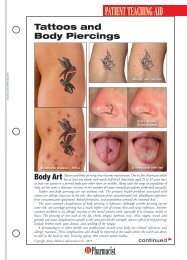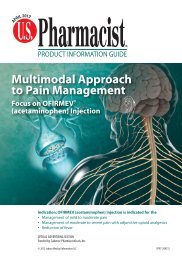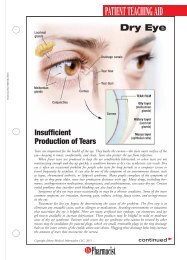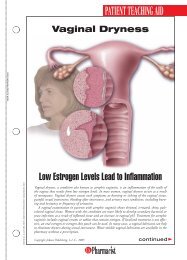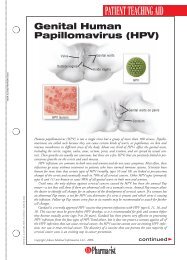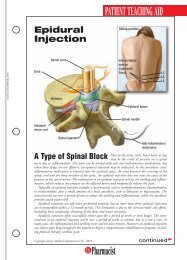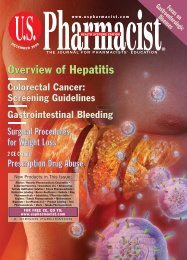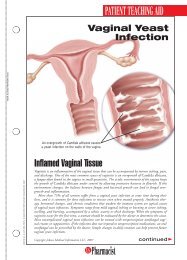View PDF Edition - U.S. Pharmacist
View PDF Edition - U.S. Pharmacist
View PDF Edition - U.S. Pharmacist
You also want an ePaper? Increase the reach of your titles
YUMPU automatically turns print PDFs into web optimized ePapers that Google loves.
Contemporary CompoundingKetamine Hydrochloride10-mg TrochesIn lozenge form, this analgesic and anesthetic agent can beprepared to suit the patient’s individual flavor preference.●FORMULAKetamine Hydrochloride 10-mg TrochesRx (for 100 troches):IngredientKetamine hydrochloride1 gSilica gel1 gStevia750 mgAcacia1.65 gCitric acid1.2 gFlavorqsPolyethylene glycol 1450qsMethod of Preparation:Calibrate the mold beingused to determine theamount of polyethyleneglycol (PEG) 1450needed. Calculate thequantity of each ingredientfor the amount to beprepared. Accuratelyweigh or measure eachingredient. Melt the PEG1450 at 50°-55°C. Blendthe powders (ketaminehydrochloride [HCl], silicagel, stevia, acacia, citricacid) and slowly sprinkleinto melted basewhile mixing; mix untiluniform. Remove fromheat, add flavor (whichcan be based on thepatient’s preference), andmix well. Pour intomolds and let mixturecool. Trim (if necessary),package, and label.Loyd V. Allen, Jr, PhDProfessor Emeritus, College ofPharmacy, University ofOklahoma, Oklahoma CityUse: Ketamine HCltroches have been usedto treat moderate-toseverepain.Packaging: Package inwell-sealed, light-resistantcontainers.Labeling: Keep out of thereach of children. Useonly as directed.Stability: A beyond-usedate of up to 6 monthsmay be used for thispreparation. 1Quality Control: Quality-controlassessment caninclude weight, specificgravity, active drug assay,color, texture–surface,appearance, feel, meltingtest, dissolution test,physical observation, andphysical stability. 2Discussion: KetamineHCl (C 13H 16ClNO.HCl,MW 274.2), an analgesicand anesthetic, occurs asa white, crystalline powderwith a slight characteristicodor. ≈1.15 mg isequivalent to 1 mg ketaminebase. It is soluble 1g in 4 mL water, 14 mLalcohol, and 60 mLabsolute alcohol. 1,3Silica gel is obtainedby insolubilizing the dissolvedsilica in sodiumsilicate solution. It occursas a fine, white, hygroscopic,odorless, amorphouspowder with ausual particle size of 2-10mu. It is insoluble inalcohol, other organicsolvents, and water, andsoluble in hot solutionsof alkali hydroxides. It isused as a desiccant, suspendingagent, and viscosity-increasingagent. 4Stevia (honey leaf,yerba dulce) is a naturalsweetening agentextracted from the Steviarebaudiana Bertoni plant.Nontoxic and safe, itoccurs as a white, crystalline,hygroscopic powder.It can be used in hotand cold preparations. 5Acacia (gum acacia,gum arabic) is the driedgummy exudate obtainedfrom some species of theacacia tree. It is a complexaggregate of sugars andhemicelluloses, with MWfrom 240,000 to 580,000.It is used as an emulsifyingagent (5%-10% concentration[conc]),pastillebase (10%-30% conc),suspending agent (5%-10% conc), and tabletbinder (1%-5% conc), aswell as in cosmetics andfood products. It shouldbe preserved when inaqueous solution, as it issubject to bacterial orenzymatic degradation.Boiling its solution brieflywill inactivate anyenzymes and enhance itsstability. Some substancesthat are incompatible withacacia are cresol, ethanol(95%), morphine, phenol,and thymol. Some saltsreduce the viscosity ofaqueous acacia solutions.Since acacia is negativelycharged in solution, it willform a coacervate withpositively charged moleculessuch as those in gelatin.Acacia may coagulatein the presence of trivalentsalts. 6Citric acid (citric acidmonohydrate,C 6H 8O 7.H 2O) occurs ascolorless or translucentcrystals or as a white, crystalline,efflorescent, odorlesspowder with a strong,tart, acidic taste. It is presentat about the 5%-8%58U.S. <strong>Pharmacist</strong> • November 2009 • www.uspharmacist.com




